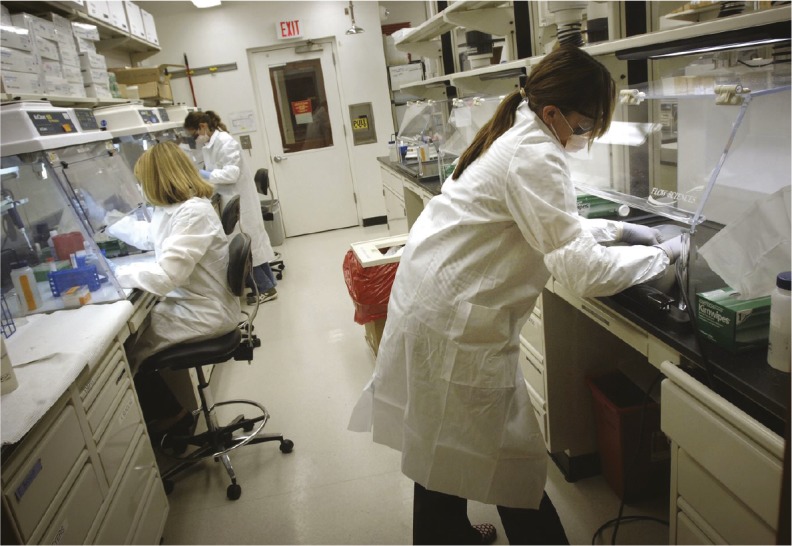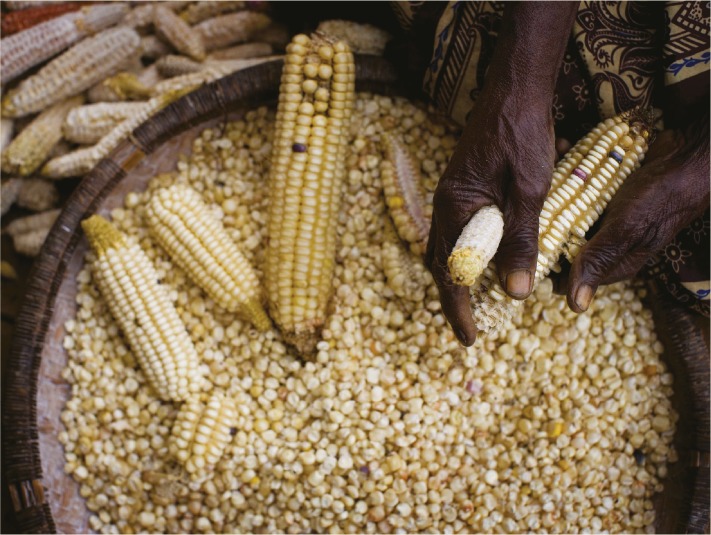Climate change and food production shocks
Maize preparation in Africa. Image courtesy of Flickr/Department of Foreign Affairs and Trade.
Volatility in the global grain market creates uncertainty for farmers and agribusiness and can lead to price spikes that reduce access to food. Climate-induced production shocks are a major contributor to market volatility. Michelle Tigchelaar et al. (pp. 6644–6649) estimated the probability of such shocks in maize production under future climate warming using empirical models of the relationship between climate and crop yields. Under 2 °C of global warming, estimated mean yields declined, whereas yield variability increased worldwide, particularly in the United States, eastern Europe, and southern Africa. The top four maize-exporting countries—the United States, Brazil, Argentina, and Ukraine—collectively account for 87% of global maize exports. At present, the probability of all four of these countries experiencing simultaneous yield losses greater than 10% of the present-day mean yield is negligible. However, the authors estimate that the probability of such simultaneous losses might increase to 7% under 2 °C warming and to 86% under 4 °C warming, leading to a higher frequency of international price spikes. According to the authors, the results emphasize the importance of both aggressive carbon dioxide emissions mitigation and breeding crops for improved heat tolerance. — B.D.
Arthropod preservation and amber resins
Amber, fossilized resin from various trees, preserves soft-bodied organisms that otherwise virtually fail to appear in the fossil record. Although finds preserved in amber have yielded important anatomical and paleoecological information, amber preservation introduces taphonomic biases, potentially failing to accurately record the composition of arthropod forest paleocommunities. Mónica Solórzano Kraemer et al. (pp. 6739–6744) analyzed the ensemble of insects and spiders naturally trapped by tree resin from Hymenaea verrucosa Gaertner, a resinous angiosperm tree in the lowland coastal forest of Madagascar, and compared it with assemblages captured by standard entomological traps placed around the same tree species. Using statistical methods, the authors demonstrate that assemblages in resins accurately reflect the arthropod species living in or near the tree, but fail to represent the arthropod community of the forest as a whole. As such, the authors note, ambers represent a suitable fossil record for research efforts limited to characterizing corresponding ancient resiniferous tree communities. Although the findings suggest that paleoecological interpretations based on certain fossil records may need to be reevaluated, the study may help reconcile unexplained aspects of previous reconstructions, according to the authors. — T.J.
Ancient DNA and adoption of agriculture in North Africa

Preparing ancient samples for DNA extraction. Image courtesy of Fred W. Baker III (photographer). The appearance of U.S. Department of Defense (DoD) visual information does not imply or constitute DoD endorsement.
The adoption of agriculture during the Neolithic Period represents a major development in human history. The process of agricultural adoption, known as the Neolithic transition, in North Africa remains largely uncharacterized, and it is unclear whether this process was driven by local populations adopting cultural and technological innovations or by the migration of people. Rosa Fregel et al. (pp. 6774–6779) tested the possibilities by performing genome-wide analyses of human remains from Neolithic archaeological sites in Morocco. Individuals from the Early Neolithic site of Ifri n’Amr or Moussa, dated to approximately 5000 BCE, had similar ancestry to Later Stone Age individuals from North Africa. This ancestral signature is largely restricted to North Africa in present-day populations. By contrast, Late Neolithic individuals from the Kelif el Boroud site, dated to approximately 3000 BCE, shared only about half of their ancestry with Early Neolithic and Later Stone Age North Africans. The remaining half of their ancestry was shared with Early Neolithic individuals from southern Spain, suggesting that migration across the Strait of Gibraltar occurred between the Early and Late Neolithic Periods. The results suggest that the early stages of the Neolithic transition in North Africa involved the adoption of technological innovations from neighboring areas by local populations, whereas subsequent migrations from Europe influenced further Neolithic developments, according to the authors. — B.D.
Evolution of RNA variants and sunflower domestication

Sunflower. Image courtesy of Wikimedia Commons/Rob Hille.
Alternative splicing is a mechanism by which genes are transcribed into an assortment of RNAs that encode functionally diverse proteins. This process allows organisms to respond to environmental changes, but its role in major evolutionary transitions is largely unknown. Chris Smith et al. (pp. 6768–6773) examined the contribution of alternative splicing to sunflower domestication—an extreme evolutionary transition that occurred approximately 5,000 years ago due to strong selection for agricultural productivity. RNA sequencing revealed that 226 transcripts showed divergent patterns of alternative splicing between wild and domesticated sunflower samples. Eight of these transcripts encode proteins with seed-specific functions—a major target of selection during domestication. Alternative splicing of the transcripts was also associated with seed germination success, further supporting a role for splicing variation in domestication fitness. Moreover, most of the domestication-specific splicing patterns were present in at least one of 10 Native American-domesticated samples and at least one of five samples from wild sunflower populations analyzed. Taken together, the results suggest that most alternative splicing patterns in domesticated sunflowers diverged early in the domestication process and likely stemmed from standing variation in wild populations. According to the authors, differences in splicing arose rapidly during a recent evolutionary transition and may have contributed to adaptation and population divergence. — J.W.



